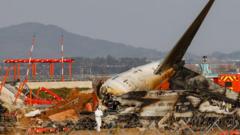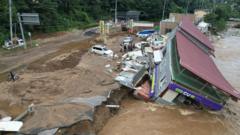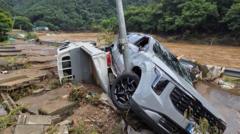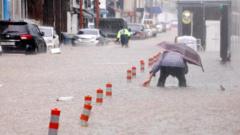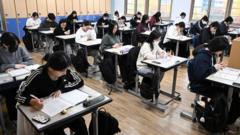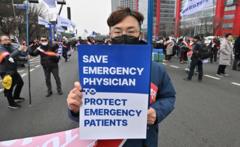At least 18 people have died and thousands evacuated due to severe flooding and landslides across South Korean provinces, with recovery efforts underway.
Landslides and Floods Claim Lives in South Korea Amid Torrential Rainfall

Landslides and Floods Claim Lives in South Korea Amid Torrential Rainfall
Devastating rainfall leads to loss of life and displacement in South Korea as authorities react to the emergency.
As South Korea grapples with the aftermath of relentless torrential rain, a tragic toll has emerged: at least 18 lives lost due to catastrophic landslides and floods that struck the nation. The government confirmed on Monday that search and rescue operations were in full swing, trying to locate nine people still unaccounted for under rubble and in swollen water bodies.
Over the past week, as much as 31 inches of rain inundated predominantly southern and western provinces, with the disaster peaking in Sancheong, a county along the central south coast. There, officials reported 10 fatalities, while the harrowing impact of impending rains prompted emergency advice for all 33,000 residents concerning potential flooding and the threat of more landslides.
Visual reports from the affected areas revealed widespread destruction, including damaged strawberry greenhouses and overturned vehicles. Local communities dealt with compounded issues such as water and power shortages as they navigated this environmental crisis. In Gapyeong County, an unfortunate incident involving a family camping by a stream resulted in the loss of a father while a mother and daughter remained missing amidst rescue efforts.
The disaster management agency indicated that approximately 14,000 residents had fled their homes, with vast areas of agriculture—equivalent to around 40,000 soccer fields—affected. The livestock sector bore the brunt of these extreme weather events, losing nearly 1.5 million animals, prominently including 1.4 million chickens.
In response, President Lee Jae Myung declared that areas severely impacted would receive special disaster zone status. This move aims to mobilize government assistance in the form of tax relief and emergency support. As rain subsided and a semblance of normality returned to most evacuated areas, communities began the arduous task of recovery. Soldiers assisted in salvaging belongings, while heavy machinery cleared debris from roads.
Despite improved weather conditions, authorities caution that more rain is anticipated for parts of central and northern South Korea, alongside warnings about a possible heatwave in the south. In proactive measures, officials are working to prevent potential disease outbreaks stemming from the flooding's aftermath, employing vehicles to dispense disinfectants throughout villages as they continue recovery efforts.
Over the past week, as much as 31 inches of rain inundated predominantly southern and western provinces, with the disaster peaking in Sancheong, a county along the central south coast. There, officials reported 10 fatalities, while the harrowing impact of impending rains prompted emergency advice for all 33,000 residents concerning potential flooding and the threat of more landslides.
Visual reports from the affected areas revealed widespread destruction, including damaged strawberry greenhouses and overturned vehicles. Local communities dealt with compounded issues such as water and power shortages as they navigated this environmental crisis. In Gapyeong County, an unfortunate incident involving a family camping by a stream resulted in the loss of a father while a mother and daughter remained missing amidst rescue efforts.
The disaster management agency indicated that approximately 14,000 residents had fled their homes, with vast areas of agriculture—equivalent to around 40,000 soccer fields—affected. The livestock sector bore the brunt of these extreme weather events, losing nearly 1.5 million animals, prominently including 1.4 million chickens.
In response, President Lee Jae Myung declared that areas severely impacted would receive special disaster zone status. This move aims to mobilize government assistance in the form of tax relief and emergency support. As rain subsided and a semblance of normality returned to most evacuated areas, communities began the arduous task of recovery. Soldiers assisted in salvaging belongings, while heavy machinery cleared debris from roads.
Despite improved weather conditions, authorities caution that more rain is anticipated for parts of central and northern South Korea, alongside warnings about a possible heatwave in the south. In proactive measures, officials are working to prevent potential disease outbreaks stemming from the flooding's aftermath, employing vehicles to dispense disinfectants throughout villages as they continue recovery efforts.


